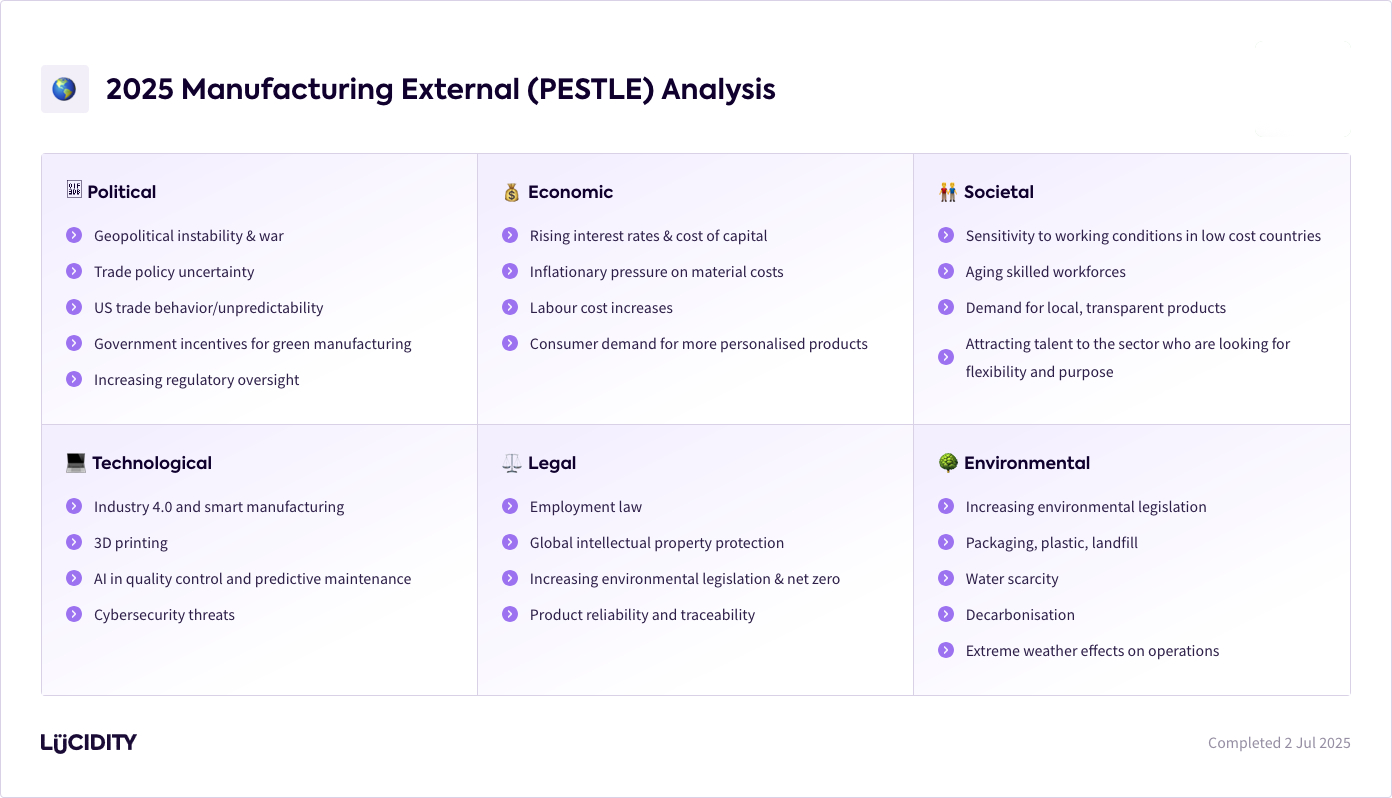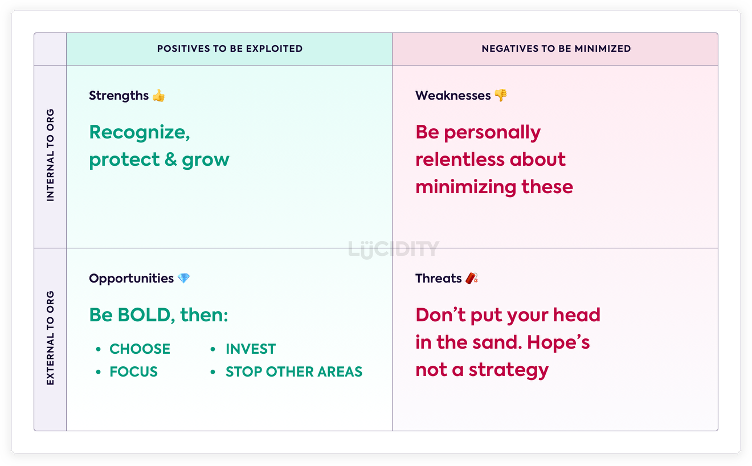Getting a structured view on whats going on around your business at times feels impossible, but actually is not difficult using simple frameworks. The PESTLE framework (Political, Economic, Societal, Technological, Legal, and Environmental) is essential for any CEO seeking to future-proof their manufacturing operations.
The 2025 PESTLE analysis below outlines the key macro-environmental forces shaping the manufacturing sector. Here’s a breakdown of each factor, what it means, and how a CEO can act on it.
🌍 Political Factors
- Geopolitical Instability & War: Conflicts disrupt supply chains and increase costs. CEOs should map vulnerabilities and consider reshoring.
- Trade Policy Uncertainty: Shifting agreements impact costs. Build compliance expertise and diversify suppliers.
- US Trade Behavior: Unpredictability affects global trade. Monitor changes and adjust strategies quickly.
- Green Incentives: Take advantage of funding for sustainable manufacturing upgrades.
- Regulatory Oversight: Strengthen ESG reporting and compliance processes.
💰 Economic Factors
- Rising Interest Rates: Higher borrowing costs mean careful capital planning is essential.
- Material Cost Inflation: Secure long-term contracts and improve forecasting.
- Labour Cost Increases: Invest in automation and talent retention.
- Product Personalisation: Prepare for low-volume, flexible manufacturing demands.
🧑🤝🧑 Societal Factors
- Working Conditions Abroad: Ensure supplier compliance with ethical standards.
- Aging Workforce: Upskill internally and invest in apprenticeships.
- Transparency Demand: Enhance product visibility and traceability.
- Talent Attraction: Create a compelling employer brand for younger workers.
💻 Technological Factors
- Industry 4.0: Adopt smart manufacturing and real-time analytics.
- 3D Printing: Explore use in prototyping and custom components.
- AI in QC & Maintenance: Predict issues before they occur to reduce downtime.
- Cybersecurity: Treat cyber risks as strategic, not just technical.
⚖️ Legal Factors
- Employment Law: Stay compliant with hybrid working and labor laws.
- IP Protection: Safeguard innovation with robust contracts and patents.
- Environmental Law: Prepare for net-zero compliance standards.
- Product Traceability: Use tech to improve product safety and recalls.
🌳 Environmental Factors
- Environmental Legislation: Use audits to stay ahead of emissions and waste mandates.
- Packaging Waste: Minimize plastic and explore sustainable materials.
- Water Scarcity: Implement conservation and monitoring solutions.
- Decarbonisation: Electrify fleets and invest in renewable energy.
- Extreme Weather: Strengthen facilities and insurance coverage.
💡 Conclusion: What Should a Manufacturing CEO Do with this External Analysis?
The 2025 PESTLE shows a world of both risk and opportunity. To navigate it:
- Strategise for resilience: Build flexibility into every process.
- Embrace sustainability: Use it as a competitive advantage.
- Invest in both tech and people: Culture matters as much as automation.
- Be proactive: Anticipate change and act decisively.
For each PESTLE factor, ask:
- What’s the risk or opportunity?
- What’s your exposure?
- Who owns the response?
- What are the next steps?
Use this analysis to guide your strategic planning, board discussions, and investment priorities in 2025 and beyond.
Lastly – what should CEOs actually do about their organisation’s strengths, weaknesses, opportunities & threats?
Your external analysis is going to hightlight some of your business stengths, weaknesses, opportunities & threats. So what should you as the leader do? Well….
Strengths – You need to recognise, protect and invest in these. Invest most in your biggest strengths if you want to build and maintain true competitive advantage.
Weaknesses – A CEO ought to eliminate what’s on this list. As the CEO, you have the authority to quickly cut through and deal with issues here that other managers may struggle to affect.
Opportunities – Choose which opportunities to focus on and cut the rest. Be brave. Strategy is about choice – what to focus on and what to say no to.
Threats – You can’t ignore these. Prioritise them and give them an owner. Use your strengths to eliminate threats. Simple example: Got a great CMO? (strength). Competition catching up? (threat). OK, so focus your CMO on running a campaign against that competitor.
Final Thoughts for the CEO
Use this as a working document: revisit your strategy, set clear objectives, and align your leadership team around 2–3 focused priorities. In today’s environment of rapid disruption and digital transformation, strategy must be both clear and flexible.
Next Steps:
- Hold a leadership strategy session to align on the biggest opportunities and threats.
- Translate each SWOT area into measurable goals or actions in your strategic plan.
- Build true competitive advantage by investing in your biggest strengths.
- Regularly update the SWOT as your market conditions, customer expectations, and internal capabilities evolve.
With clarity and discipline, this analysis can be the start of a confident and effective strategic roadmap for your manufacturing business.













